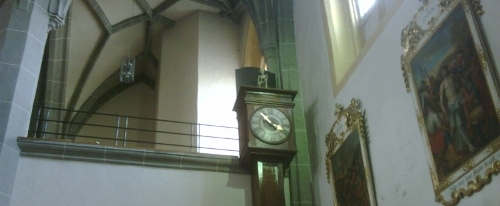When more than thirty years are told,
As good as dead one is indeed
Goethe, Faust II
“Why Slow Media?” This is certainly one of the questions we get asked most frequently on events and in many conversations. “Why do you ask for more slowness in media?” For me, Hippocrates’ famous aphorism Ὁ μὲν βίος βραχύς ἡ δὲ τέχνη μακρά that has been put even more concisely by Seneca, vita brevis, ars longa, is the foundation of Slow Media – if not for all different streams of the Slow Movement.
Life simply is too short to surround oneself with bad things, to eat bad food or to read bad magazines, websites and books. Especially when approaching the middle years of one’s life and the last deadline (what an apt term!) is moving closer and closer. One of the most intense visualizations of this fact is the “Death of Altötting”, a figure that mows the remaining seconds of remaining time with a scythe.
The key question that has provoked many different answers in intellectual history, is: How to deal with this mismatch of limited life-time and unlimited culture and arts? How to deal with the awareness, that one can enjoy at best a tiny fraction of all books, films, magazines or people? Roughly sketched, there is a quantitative and a qualitative way to handle this dilemma.
The quantitative or Protestant way tries to realize as much as possible from this potential with the help of a strict plan or timetable. Benjamin Franklin’s slogan “time is money” is the clearest expression of this philosophy. It demands to productively exploit every single second of the day and to waste nothing of this precious resource by being lazy or self-indulgent. Thrift is the ideal, towards which the short remaining life should be oriented.
How different does the other way look! It focuses on quality of the borrowed time. Here, the aim is not to squeeze as much activity as possible into limited time – young adults in the U.S., for example, achieve to stuff 10:45 hours media time into just 7:38 hours life-time by parallel use of different media (Franklin surely would applaud this efficiency), but to spend the hours as well as possible. Our Slow Media Manifesto could be summed up in one sentence: Time is too short for bad media.
Collège de France philologist Harald Weinrich recounts all possible facets of this phenomenon in his highly readable book “On Borrowed Time”. One of his key points is the dualism between aged Chronos (Χρόνος), who is approaching death with a high tempo and always youthful Kairos (καιρός) who stands for the wise use of time and opportunity, which can be clearly seen in his most famous depiction:
One of his most peculiar features is his almost completely shaven head. Only on his forehead remains one head of hair. If a terrestrial being wants to catch and hold this agile god, he will have to face him and try to catch his hair. If he misses, than his hand will find no hold on the smooth skull and the right moment has been missed and slipped. [Own translation]
Even for media, there is a right time. Not every slow or fast medium is for everyone, everywhere and always the right one. But in many cases the slow, inspiring and sustainable option is the more convenient choice. And it also gives you the feeling that you have spend your brief time the best possible way.
Paradoxically, this will often be the cheaper option. Just as the flea market purchase of a high quality unused porcelain tea-set from 1957 is much cheaper than buying a nameless industrial product in a Swedish furniture store or faux-antique goods in nostalgia supermarkets, the joy of reading a very well-made book with a patina will be less expensive than the collection of cheap novel editions of newspaper publishers.
Slow Media should not to be misunderstood as a plea for something one could describe with reference to period furniture as period media. Slow Media advocates authentic media, regardless of whether bought at the newsstand (Wired, Intelligent Life, Make, Brand eins) or passed down for generations. Anything else is time wasted.




2 replies on “Slow Media and borrowed time”
[…] reading: The End of History – for creative professionals. On Lent Slow Media and borrowed time “So literature collapses before our eyes” – Non-Commodity […]
[…] What is the essence of our life? It is the moment that we live to see. In it we find our expectations of the future as well as our memories of what has passed. Thus our life flows moment after moment through our consciousness. Everything that we experience has its moment in time – and by nature our life span is limited: “Live is just too short, to mess about with bad things.” is one basic idea of this Slow-Media-Blog. […]